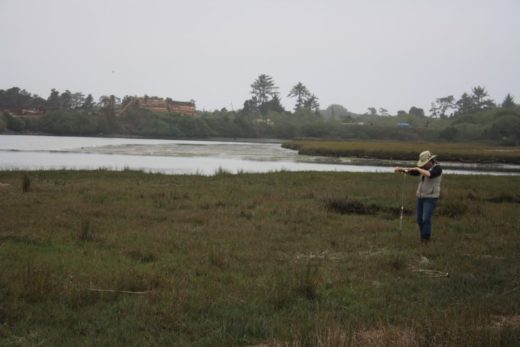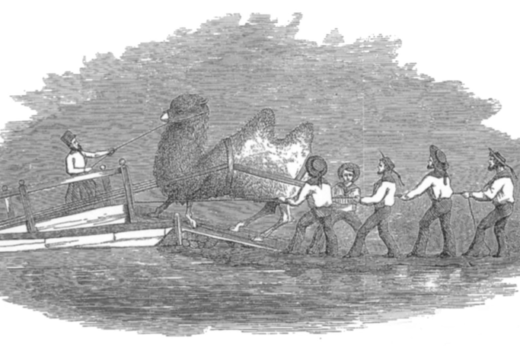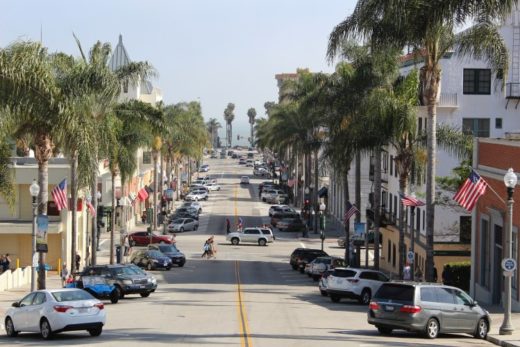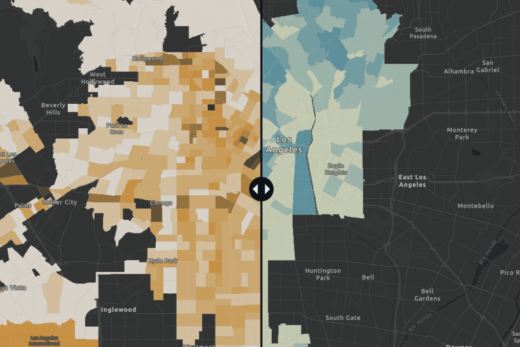Part II: Gravity Takes Control in another California Adventure
The water that we have shadowed for days and thousands of miles was temporarily confined in the frozen state under layers of snow, similar to what you might find in other mountain ranges from the Oregon Border (where snow packs can accumulate much deeper) all the way down to Mt. Palomar and the Laguna Mountains near the Mexican Border (where deep snowpacks are more rare) (E15).

Our giant ice crystals must wait in Yosemite’s high country until an unlikely warm winter storm pours melting, flooding rains over them, or until the more likely seasonal thaw melts them during late spring or early summer. Every year is different, especially recent years (E16). This year’s melt would begin during April’s long, bright days between late-season snow flurries. May brought more warm sunshine until our ice crystals saw the light of day after the overlying layers of white and pale blue wasted away. Our crystals finally emerged out into the open and into view in that subalpine environment just above 9,000’ elevation. On the higher, colder alpine slopes that towered above this habitat, the snowpacks would have to wait days or weeks later before joining the melting festivities.

There were only three options from here, as the surrounding snowpack continued to defrost. Some of the ice melted and later evaporated into the dry mountain air; in other cases, the air was so dry and the ice and snow gained energy so quickly, it changed directly into vapor, a process known as sublimation (E17). These umpteen transparent water vapors with their absorbed energy (or latent heat) took off on a new ride with another air parcel within another air mass. The second option was for the ice and snow to melt and soak into the ground under the force of gravity. Some of this water might be absorbed by the soil only to be absorbed again by the roots of trees and other plants that would eventually, through transpiration, release water vapor back into the atmosphere. Another portion of this ground water would follow the many shallow or deeper joints and fractures within the granitic rocks and eventually flow out as natural springs at lower elevations (E18).

Our melted ice took the third option. It soaked into already saturated soil covered with pine needles and accumulated with more snowmelt until there was enough water to flow just below the visible surface. You may have encountered this sort of interflow or throughflow when you thought you were walking on to dry soil, but began squishing into the saturated quagmire under whatever grass or other cover was disguising the water. As our water drop combined with the surrounding snowmelt and flowed slowly downhill around the numerous needles, sticks, decaying logs, and other organic obstructions that had accumulated on the ground, there was finally enough water to emerge from the saturated soil, resulting in a form of overland flow. Overlapping layers of water accumulated on the slope’s surface as sheetflow so that it now quickly made its way down into tiny channels, or rills and gullies, where the velocity of the water accelerated as channel flow (E19). Our water drop found itself in a little creek and was now fully engaged in what we term “fluvial processes” common to running water. This channeled water merged with other larger channels or tributaries and became a fast-flowing stream cascading over rocks and cutting through thicker ribbons of trees and other species that line stream banks and combine as riparian plant communities. As gravity pulled our water to lower elevations, the connecting tributary streams finally merged with the main river course that would flow toward the west: The Merced River.

It is important here to consider what could have happened if our now-melted snowflake had carried a little bit farther east in the storm and fallen on the opposite side of the drainage divide, into the steeper leeward terrain of the eastern Sierra Nevada. After melting, it might have flowed into Mono Lake, a revered (and nearly memorialized) stranded high-desert lake with its evaporating water that has become saltier than the ocean, thanks to being stranded in its closed basin and robbed of replenishing runoff by the Los Angeles Department of Water and Power. Or, it could have flowed down into the headwaters of the Owens River and headed on a long trip south, only to evaporate in shallow pools such as what was once Owens Lake. These are typical adventures for water that is captured within, and then evaporated from, inland drainages in California; that is why their dehydrated playas, with their layers of precipitated salts, often glisten at the bottom of enclosed desert basins.

Another drop, flowing down the eastern slopes, could also have been diverted by the Los Angeles Department of Water and Power into the L.A. Aqueduct, only to be directed hundreds of miles south until it finally gushed out of a sprinkler and on to an urban or suburban landscape, or through someone’s faucet and into their kitchen sink or bathroom. Those are very different drainage basin adventures that would have taken our water drop in a very different direction on a very different kind of wild journey. But, since it fell as a snowflake on the west side of the drainage divide, our water drop’s destiny will be determined within the Merced River Drainage Basin that eventually slopes and drains west, toward the Central Valley.

Back to our trip with our water drop down the Merced River, a breathtaking wild ride followed. Occasionally, the river would slow a bit, spread out, and meander through a meadow. But it was surrounded by spectacularly steep glacial topography along a course that was once covered by powerful alpine valley glaciers that repeatedly carved through this canyon more than 11,000 years ago. The river would drop more than 8,000 feet within 25 miles from its headwaters (E20). Our water drop began tumbling along and cascading in this turbulence until it plunged hundreds of feet over granitic rocks into Nevada Falls and again within Vernal Falls with forces that would kill any human (as happens in many years) or animal unfortunate enough to slip into the current.




Then, the river slowed again and meandered through meadows in one of the most spectacular mountain valleys in the world, as if to give our water drop a chance to admire the scenery as it passed through (E21). Flowing farther away from Half Dome, it passed by Yosemite Falls, El Capitan’s vertical rock face, and Bridalveil Fall, gaining discharge from the commingling tributaries. But now our water drop and its adopted river were encountering new influencers that would change the nature of this designated wild and scenic waterway as it progressed farther downstream: humans. At first, they were ecotourists eager to enjoy some of the same views and experiences as our water drop, but they would soon become the newest most powerful force along our river course.

As the Merced River carried our water drop west and out of Yosemite Valley, it plunged into the narrow Merced River gorge, with a gradient of about 70 feet/mile. Just before the gorge, hydrologists have measured enormous variations in discharge on this river that include low flows in late autumn and extreme high flows during spring or early summer snowmelts, or during unusually warm winter storms that have suddenly melted the watershed’s snowpack. These measurements have ranged from about 10 cfs during driest years to about 25,000 cfs during the worst flood years (E22). The lag times between peak precipitation and peak runoff are just as variable, depending on the types of storms and weather conditions that follow them. After cascading through this gorge, our water was riding its way out of these mountains as it flowed west, through the lower-elevation foothills, toward a new and unfamiliar environment called the Great Central Valley. And though it continued to nurture adjacent water-loving riparian plant communities, the surrounding ecosystems were becoming noticeably more xeric. Forests thinned to woodlands or dense chaparral ground cover that would finally blend into dehydrated grasslands at lower elevations parched by the Central Valley sun.


As its velocity occasionally slowed along gentler gradients, the river would eventually and spasmodically deposit the large- and small-sized sediment it eroded and transported out of these mountains. As it was changing from a degradational stream to a stream in the aggradational phase (E23), the river encountered plenty of human interference and modifications in its bed, some designed to catch and control excess amounts of sediment that could otherwise damage infrastructures downstream (E24). Our water drop’s motion was abruptly slowed to a near halt when it flowed into the calm waters of Lake McClure, which sits behind the new Exchequer Dam. This reservoir can fill to more than 1 million acre feet of water during wet years, but it has also dried to a stagnant pool of less than 65,000 acre feet (about 6% of capacity) during severe droughts. In this more typical runoff season, our water would have to flow through no less than four reservoirs and their dams to get to the valley floor. They are designed with multiple purposes that include flood control, water storage for residential use and dry season farm irrigation, electricity production, wildlife habitat, and occasional recreation. Irrigation canals, levee construction, and mining operations are among the other human modifications that have destroyed natural riparian habitats and reshaped the nature of the lower Merced River.



After flowing into, through, and around all these engineering imprints on the river course, the water has had multiple opportunities to evaporate or be diverted or to soak into aquifers, helping to eventually recharge essential groundwater basins. This is where many Sierra Nevada streams often become influent, as flow percolates into the permeable subsurface. (The foundation of the Central Valley floor consists primarily of porous and permeable sediment and sedimentary rock that can accept and store enormous volumes of water.) But our water drop has survived all of this, and the many tentacles of the Merced Irrigation District, to finally burst past Crocker-Huffman Dam. It is accompanied by a highly-controlled discharge that has been cut by at least half, compared to the unobstructed flows prior to human diversions.

These engineering marvels that keep floods at bay, provide us with water during dry months, and generate hydropower, have been built along nearly every major river that flows out of the Sierra Nevada. But they also contribute to thermal and other types of pollution and they are barriers to the millions of fish that once swam up these streams and into higher terrain to spawn. Here, our water flows through a fish hatchery to restore Chinook salmon that once swam upstream from the ocean in attempts to complete their life cycles, a colossal pilgrimage that was repeated for thousands of years before humans. Today, it represents their last natural stop, since their first dam barrier rises just upstream. Such fish hatcheries across the state are designed to nurture threatened fish populations and help support today’s multi-billion-dollar recreational and commercial fishing industries. You will find more information about the fish hatcheries, and how some California waterways (similar to the Merced), have been polluted with mercury, in separate stories on our web page.


Our water drop finally, by some small miracle, makes it through or around these distractions and merges into the San Joaquin River at the bottom of the valley. It will now flow within this once-powerful river that has been reduced to one of most intensely engineered and human-modified major water courses in the world. Flowing northwest, past San Joaquin Valley farmland, it enters the Sacramento-San Joaquin Delta. You can read volumes about how this once rich delta, with surely endless miles of productive wetlands that nurtured seemingly countless varieties of species, was converted to farmland more than a century ago. Epic stories of delta floods and “reclamation” and more recent flood hazards can be found on our web page and in our publication. But our water drop is now meandering through the Delta’s maze of tranquil, sinuous channels only to pass by what is left of its fertile wetlands and today’s adjacent productive farmlands, toward San Francisco Bay.




Much of the surrounding water may be caught in an almost deceptive attraction south, toward the giant pipes and pumps that could suck it out and drop it into the California Aqueduct. This water will then flow and be pumped farther south to become irrigation for San Joaquin Valley farms, or it may even later be pulled all the way up and over the Tehachapis and into thirsty southern California neighborhoods and cities. By now, the relationship between humans and water in the Golden State has become clearer. Water often ends up getting diverted into one of the many blue ribbons of aqueducts where it’s “not supposed to be”, while abandoned river beds become dry strips of sand where water once flowed naturally. If there is any truth to the sarcastic idiom that “water flows uphill toward money”, the expression has been especially true in California.


In this case, our water drop managed to avoid the great pumps and those southern fates as it creeps farther west, closer to San Francisco Bay. It merges with this year’s snowmelt runoff from the mighty, though thoroughly-tamed, Sacramento River, which contributes considerably more fresh water from the north. Our drop has gradually navigated past the many delta “islands” that are protected by aging levees, holding steady for now, as it encounters saltier water. As it enters Suisan Bay, salt water pushes inland during high tide, but fresh water pushes back and accelerates west toward the bays during low tide. Our water drop is caught in this oscillating ebb and flow dance: two steps forward, one step back. It finally squeezes through Carquinez Strait and then spills into San Pablo Bay and hesitates on into San Francisco Bay. The back and forth motion is eventually overcome by the push of fresh water during low tide (E25), and so it rushes by Angel and Alcatraz Islands, under the Golden Gate Bridge and out to sea.




Circulating Back to Where We Started: Oceanographic Adventures
As was so often true throughout this journey, there could be different paths from here. But our increasingly salty water is cast out far enough to be captured by the powerful California Ocean Current (E26) that pushes cold water from north to south along the coast. It could evaporate and its water vapors condense again in the chilled air to help create the iconic, misty advection fog that drifts onshore along the California coast (E27). Or, it could become colder and/or more salty and denser so that it would sink into the abyss to join the coldest, deeper ocean water currents that may not reemerge for many years.


But our water is now moving slow but steady on the surface with the California Current. It passes the Channel Islands and then continues south, veering right off of Baja, Mexico and toward Hawaii. Caught in the great clockwise wheel of the North Pacific Gyre (E28), it continues veering to its right as it crosses the Pacific Ocean, where warmer water temperatures can support the development of late summer tropical storms and hurricanes, and then the Western Pacific’s typhoons. It turns toward the north off of Japan and continues up toward the Gulf of Alaska as a relatively warm current. And what a surprise to find a few of those anadromous Chinook salmon, which were born at the Merced River Fish Hatchery and in other California streams and rivers. In a few years, they will have completed their own life cycles in this ocean and will return to the Golden State, following their original routes in reverse, until they spawn and die along some of those same California waterways that we navigated a few years ago.
For now, driven by the laws of nature and touched by a lot of luck and fate, our water drop has returned to near where we “started” our wild journey a few years earlier, within these stormy seas. Armed with your knowledge about hydrology, we’ll let your imagination run wild to consider the countless other paths and transformations, the seemingly endless possibilities, that might help us recognize and appreciate the potential story that every California water drop could tell. This is where we acknowledge how interactions between the interconnected land, air, fresh water, oceans, and living organisms combine to help us understand the awesome natural and vital systems and cycles that rule in our state and on our Earth.

It all “started” in the North Pacific Ocean when surface water gained enough energy to evaporate into a passing air mass that was not yet near saturation (E29)…
Epilogue
As with most dramas, what didn’t happen to our California water drop may offer far more possibilities for intrigue and suspense, compared to the unlikely story told here. But each of these countless other individual and unlikely options, prospects, and stories, added together, combine to make our Earth’s water cycles. Why do we bother? Fresh air, clean water, nutritious food, shelter, our health: these are all the necessary ingredients for our survival on this Earth. Without them we can’t do anything else or experience anything else. But, we too often lose site of what is most important, thanks to the cacophony that constantly attempts to distract us from these truths in today’s California. So, our water drop adventures have reconnected us to our source, the H2O that can refresh and nurture us or terrorize and kill us.

And this brings us back to consider our relationships with water and the water drop we followed here. Whether that relationship is mystical and spiritual or purely scientific, we have much to learn from water as it travels through our state and around our planet. And if you considered the water drop autobiography that began this story to be a little too rudimentary or even fatuous, consider the following story told by an elder Wintu woman in 1930. The quote was recorded by ethnographer Dorothy Demetrocopoulou and it appeared in the UC Press publication, The Natural World of the California Indians, by Robert Heizer and Albert Elsasser. The Wintu (or Wintun) lived around the Sacramento River and some of its tributaries for centuries, long before this land was called California, even longer before the great water projects. Her quote suggests that Native Americans may have encountered our water drop and shared their own stories about its adventures.
The water, it can’t be hurt. The white people go to the river and turn it into dry land. The water says, “I don’t care. I am water. You can use me all you wish. I am always the same. I can’t be used up. Use me. I am water. You can’t hurt me.” The white people use the water of sacred springs in their houses. The water says, “That is alright. You can use me but you can’t overcome me.” All that is water says this. “Wherever you put me I’ll be in my home. I am awfully smart. Lead me out of my springs, lead me from my rivers, but I came from the ocean and I shall go back to the ocean. You can dig a ditch and put me in it, but I go only so far and I am out of sight. I am awfully smart. When I am out of sight, I am on my way home.
You might notice that the Wintu, as with other Native Americans, were different sorts of applied geographers and hydrologists, but you can also sense that they recognized their vital connections to water more clearly than many present-day Californians.
This quote from renowned writer Toni Morrison is an ideal way to “end” our story that has really just begun: “All water has a perfect memory and is forever trying to get back to where it was.”





